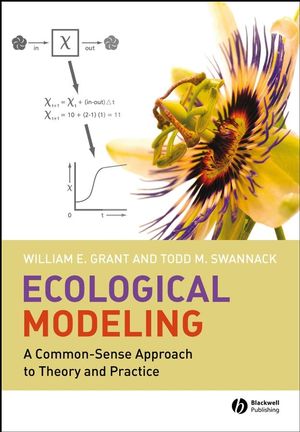Ecological Modeling: A Common-Sense Approach to Theory and PracticeISBN: 978-1-4051-6168-8
Paperback
176 pages
December 2007, Wiley-Blackwell
 This is a Print-on-Demand title. It will be printed specifically to fill your order. Please allow an additional 10-15 days delivery time. The book is not returnable.
|
||||||
Acknowledgments.
1 Introduction.
1.1 Common-Sense Solutions: Three Exercises.
1.2 Modeling Theory.
1.3 Modeling Practice.
1.4 Theory, Practice, and Common Sense.
1.5 Intended Use of this Book.
Part 1 Common-Sense Solutions: Three Exercises.
2 Common-Sense Solutions.
2.1 Three Problems.
2.1.1 Harvesting Food for the Winter.
2.1.2 Estimating the Probability of Population Extinction.
2.1.3 Managing the Commons.
2.2 The Systems Approach to Problem Solving.
2.2.1 The Conceptual Model (Phase I).
2.2.2 The Quantitative Model (Phase II).
2.2.3 Model Evaluation (Phase IIII).
2.2.4 Model Application (Phase IV).
2.3 The Three Problems Revisited: The Systems Approach in Theory and Practice.
Part 2 Modeling Theory.
3 Theory I: The Conceptual Model.
3.1 State the Model Objectives (Ia).
3.2 Bound the System-of-Interest (Ib).
3.3 Categorize the Components within the System-of-Interest (Ic).
3.3.1 State Variables.
3.3.2 Material Transfers.
3.3.3 Sources and Sinks.
3.3.4 Information Transfers.
3.3.5 Driving Variables.
3.3.6 Constants.
3.3.7 Auxiliary Variables.
3.4 Identify the Relationships among the Components That Are of Interest (Id).
3.4.1 Submodels.
3.5 Represent the Conceptual Model (Ie).
3.5.1 Conceptual-Model Diagrams.
3.6 Describe the Expected Patterns of Model Behavior (If).
4 Theory II: The Quantitative Model.
4.1 Select the General Quantitative Structure for the Model (IIa).
4.2 Choose the Basic Time Unit for the Simulations (IIb).
4.3 Identify the Functional Forms of the Model Equations (IIc).
4.3.1 Information on Which to Base the Choice of Functional Forms.
4.3.2 Selecting Types of Equations to Represent the Chosen Functional Forms.
4.4 Estimate the Parameters of the Model Equations (IId).
4.4.1 Statistical Analyses within the Context of Simulation Model Parameterization.
4.4.2 Quantifying Qualitative Information.
4.4.3 Deterministic- versus Stochastic-Model Parameterization.
4.5 Execute the Baseline Simulation (IIe).
4.5.1 Baseline Simulations for Stochastic Models.
5 Theory III: Model Evaluation.
5.1 Assess the Reasonableness of the Model Structure and the Interpretability of Functional Relationships within the Model (IIIa).
5.2 Evaluate the Correspondence between Model Behavior and the Expected Patterns of Model Behavior (IIIb).
5.3 Examine the Correspondence between Model Projections and the Data from the Real System (IIIc).
5.3.1 Quantitative versus Qualitative Model Evaluation.
5.4 Determine the Sensitivity of Model Projections to Changes in the Values of Important Parameters (IIId).
5.4.1 Interpreting Sensitivity Analysis within a Model Evaluation Framework.
6 Theory IV: Model Application.
6.1 Develop and Execute the Experimental Design for the Simulations (IVa).
6.2 Analyze and Interpret the Simulation Results (IVb).
6.3 Communicate the Simulation Results (IVc).
Part 3 Modeling Practice.
7 Some Common Pitfalls.
7.1 Phase I: Pitfalls: The Conceptual Model.
7.2 Phase II Pitfalls: The Quantitative Model.
7.3 Phase III Pitfalls: Model Evaluation.
7.4 Phase IV Pitfalls: Model Application.
8 The Modeling Process In Practice.
8.1 Preliminary Conceptual Model (CM).
8.1.1 How to Begin.
8.1.2 Adding New Components to the Model.
8.1.3 Describing Expected Patterns.
8.1.4 Describing the Plan of Attack.
8.2 Intermediate Developmental Models (IDMi).
8.2.1 Evaluate-Adjust Cycle for each Developmental Model.
8.2.2 Sensitivity Analysis of the Last Developmental Model.
8.3 Final Model (FM).
Part 4 Theory, Practice, and Common Sense.
9 The Common-Sense Problems Revisited.
9.1 Harvesting Food for the Winter.
9.1.1 The Preliminary Conceptual Model (CM).
9.1.2 The Last (only) Intermediate Developmental Model (IDMlast).
9.1.3 The Final Model (FM).
9.2 Estimating the Probability of Population Extinction.
9.2.1 The Preliminary Conceptual Model (CM).
9.2.2 The Intermediate Developmental Models (IDMi).
9.2.3 The Final Model (FM).
10 Reflections.
10.1 The Systems Approach as a Complement to Other Methods of Problem Solving.
10.2 Ecological Modeling as a Problem-Solving Process.
10.3 Expectations for Ecological Models.
10.4 A Final Thought.
References.
Appendix A: Introduction To The Ecological Modeling Literature.
Appendix B: Scientific Reports For The Examples in Chapter 2.
B.1: Effect of Deforestation on Rate of Food Harvest.
B.2: Effect of Hurricane Frequency on Probability of Population Extinction.
B.3: Effect of Stocking Rate on Forage and Animal Production.
Index



